Analysis of Spatial and Temporal Evolution of Ecosystem Services and Driving Factors in the Yellow River Basin of Henan Province, China
Abstract
:1. Introduction
2. Materials and Methods
2.1. Overview of the Study Area
2.2. Data Sources
2.3. Functional Analysis of Ecosystem Services under the Invest Model
2.3.1. Carbon Stock Modules
2.3.2. Water Yield Module
2.3.3. Soil Conservation Module
2.4. Carbon Stock Estimation Based on Multi-Source Data
2.4.1. Feature Variable Extraction
2.4.2. Forest Biomass Estimation Model
2.5. Geodetector-Based Analysis of Ecosystem Service Function Drivers
3. Results and Analysis
3.1. InVEST Model Assessment Results and Analysis
3.1.1. Carbon Stock Assessment Analysis, 2000–2020
- (1)
- Spatial and temporal variations in carbon stock
- (2)
- Carbon stock in different land types
3.1.2. Assessment and Analysis of Water Yield, 2000–2020
- (1)
- Spatial and temporal variations in water yield
- (2)
- Water yield in different land use types
3.1.3. Soil Conservation Assessment Analysis from 2000 to 2020
- (1)
- Spatiotemporal changes in soil conservation
- (2)
- Soil conservation in diverse land types
3.2. Analysis of Drivers of Ecosystem Service Function
3.2.1. Analysis of Carbon Stock Drivers
3.2.2. Analysis of Water Yield Drivers
3.2.3. Analysis of Soil Conservation Drivers
4. Discussion
4.1. Methodological Limitations
4.2. Results Discussion
4.3. Socio-Ecological Implications
5. Conclusions
- (1)
- The total carbon stock shows an increasing trend, going from 6.33 × 108 t in 2000 to 6.45 × 108 t in 2020. Total water yield showed a “falling-rising” pattern, with a low of 5.23 × 1010 m3 in 2015 and a peak of 7.37 × 1010 m3 in 2000. The total soil conservation exhibits a “decline-rise-decline-rise” pattern, with an overall decreasing trend.
- (2)
- The spatial distribution of the three ecosystem services has a high degree of consistency. The southwestern, central-eastern, and northern regions of the study area demonstrate better ecosystem service functions, with higher levels of carbon stock, water yield, and soil conservation. The land use distribution in these regions is predominantly forested.
- (3)
- Broad-leaved forests had the highest carbon stock per unit area, followed by coniferous forests. Coniferous and broad-leaved mixed forests ranked highest for water yield density. Soil conservation was highest in coniferous and broad-leaved mixed forests.
- (4)
- Population density primarily influenced changes in carbon stock. Water yield was mainly driven by precipitation, while soil conservation was most affected by slope. Population density ∩ DEM and precipitation provide the strongest explanatory power for carbon stock. The interaction between precipitation and other factors exhibits the highest explanatory power for water yield. Similarly, slope ∩ precipitation shows the greatest explanatory power for soil conservation.
Author Contributions
Funding
Institutional Review Board Statement
Informed Consent Statement
Data Availability Statement
Conflicts of Interest
References
- Costanza, R.; d’Arge, R.; de Groot, R.; Farber, S.; Grasso, M.; Hannon, B.; Limburg, K.; Naeem, S.; O’Neill, R.V.; Paruelo, J.; et al. The value of the world’s ecosystem services and natural capital. Nature 1997, 387, 253–260. [Google Scholar] [CrossRef]
- Daily, G.C. Nature’s Services: Societal Dependence on Natural Ecosystems; Island Press: Washington, DC, USA, 1997. [Google Scholar]
- Ouyang, Z.; Wang, R.; Zhao, J. Ecosystem services and their economic valuation. Chin. J. Appl. Ecol. 1999, 635–640. [Google Scholar]
- Fu, B.; Zhou, G.; Bai, Y.; Song, C.; Liu, J.; Zhang, H.; Lv, Y.; Zheng, H.; Xie, G. The main terrestrial ecosystem services and ecological security in China. Adv. Earth Sci. 2009, 24, 571–576. [Google Scholar]
- Fu, S.; He, C.; Ma, J.; Wang, B.; Zhen, Z. Ecological environment quality of the Shanxi section of the Yellow River Basin under different development scenarios. Chin. J. Appl. Ecol. 2024, 35, 1337–1346. [Google Scholar]
- Miao, C.; Ai, S.; Zhao, J.; Shao, T.; Cui, Y.; Guo, X. Research on ecological protection and high-quality development strategy of the Yellow River Basin. Yellow River Civiliz. Sustain. Dev. 2021, 123–132. [Google Scholar]
- Dragicevic, A.; Lobianco, A.; Leblois, A. Forest planning and productivity-risk trade-off through the Markowitz mean-variance model. For. Policy Econ. 2016, 64, 25–34. [Google Scholar] [CrossRef]
- Birdsey, R.; Pregitzer, K.; Lucier, A. Forest Carbon Management in the United States. J. Environ. Qual 2006, 35, 1461–1469. [Google Scholar] [CrossRef] [PubMed]
- Marsh, G.P. Man and Nature: Or, Physical Geography as Modified by Human Action; C. Scribner: New York, NY, USA, 1864. [Google Scholar]
- Holdren, J.P.; Ehrlich, P.R. Human population and the global environment. Am. Sci. 1974, 62, 282–297. [Google Scholar] [PubMed]
- Huang, C.; Yang, J.; Zhang, W. Development of ecosystem services evaluation models: Research progress. Chin. J. Ecol. 2013, 32, 3360–3367. [Google Scholar]
- Babbar, D.; Areendran, G.; Sahana, M.; Sarma, K.; Sivadas, A. Assessment and prediction of carbon sequestration using Markov chain and InVEST model in Sariska Tiger Reserve, India. J. Clean. Prod. 2021, 278, 123333. [Google Scholar]
- Mushet, D.M.; Neau, J.L.; Euliss, N.H. Modeling effects of conservation grassland losses on amphibian habitat. Biol. Conserv. 2014, 174, 93–100. [Google Scholar] [CrossRef]
- Dashtbozorgi, F.; Hedayatiaghmashhadi, A.; Dashtbozorgi, A.; Ruiz–Agudelo, C.A.; Fürst, C.; Cirella, G.T.; Naderi, M. Ecosystem services valuation using InVEST modeling: Case from southern Iranian mangrove forests. Reg. Stud. Mar. Sci. 2023, 60, 102813. [Google Scholar] [CrossRef]
- Zhao, S.; Zhou, D.; Wang, D.; Chen, J.; Gao, Y.; Zhang, J.; Jiang, J. Ecosystem carbon storage assessment and multi-scenario prediction in the Weihe River Basin based on PLUS-InVEST model. Chin. J. Appl. Ecol. 2024, 35, 1–14. [Google Scholar]
- Dai, E.; Wang, Y. Spatial heterogeneity and driving mechanisms of water yield service in the Hengduan Mountain Region. Acta Geogr. Sin./Dili Xuebao 2020, 75, 607–619. [Google Scholar]
- Wu, J.; Zhang, L.; Peng, J.; Feng, Z.; Liu, H.; He, S. The integrated recognition of the source area of the urban ecological security pattern in Shenzhen. Acta Ecol. Sin. 2013, 33, 4125–4133. [Google Scholar]
- Yang, D.; Liu, W.; Tang, L.; Chen, L.; Li, X.; Xu, X. Estimation of water provision service for monsoon catchments of South China: Applicability of the InVEST model. Landsc. Urban Plan. 2019, 182, 133–143. [Google Scholar] [CrossRef]
- Wang, R.-Y.; Mo, X.; Ji, H.; Zhu, Z.; Wang, Y.-S.; Bao, Z.; Li, T. Comparison of the CASA and InVEST models’ effects for estimating spatiotemporal differences in carbon storage of green spaces in megacities. Sci. Rep. 2024, 14, 5456. [Google Scholar] [CrossRef]
- Kohestani, N.; Rastgar, S.; Heydari, G.; Jouibary, S.S.; Amirnejad, H. Spatiotemporal modeling of the value of carbon sequestration under changing land use/land cover using InVEST model: A case study of Nour-rud Watershed, Northern Iran. Environ. Dev. Sustain. 2024, 26, 14477–14505. [Google Scholar] [CrossRef]
- Bai, X.M.; Shi, P.J.; Liu, Y.S. Realizing China’s urban dream. Nature 2014, 509, 158–160. [Google Scholar] [CrossRef]
- Yu, Y.Q.; Huang, Y.; Zhang, W. Modeling soil organic carbon change in croplands of China, 1980–2009. Glob. Planet. Chang. 2012, 82–83, 115–128. [Google Scholar] [CrossRef]
- Bryan, B.A.; Gao, L.; Ye, Y.Q.; Sun, X.F.; Connor, J.D.; Crossman, N.D.; Stafford-Smith, M.; Wu, J.G.; He, C.Y.; Yu, D.Y.; et al. China’s response to a national land-system sustainability emergency. Nature 2018, 559, 193–204. [Google Scholar] [CrossRef] [PubMed]
- Ouyang, Z.; Zheng, H.; Xiao, Y.; Polasky, S.; Liu, J.; Xu, W.; Wang, Q.; Zhang, L.; Xiao, Y.; Rao, E.M.; et al. Improvements in ecosystem services from investments in natural capital. Science 2016, 352, 1455–1459. [Google Scholar] [CrossRef]
- Xi, J. Speech at the Symposium on ecological protection and quality development of the Yellow River basin China. China Water Resour. 2019, 70, 1–3. [Google Scholar] [CrossRef]
- Jin, F. Coordinated promotion strategy of ecological protection and high-quality development in the Yellow River Basin. Reform 2019, 32, 33–39. [Google Scholar]
- Shen, J.; Zhao, M.; Tan, Z.; Zhu, L.; Guo, Y.; Li, Y.; Wu, C. Ecosystem service trade-offs and synergies relationships and their driving factor analysis based on the Bayesian belief Network: A case study of the Yellow River Basin. Ecol. Indic. 2024, 163, 112070. [Google Scholar] [CrossRef]
- Zhang, K.; Fang, B.; Zhang, Z.; Liu, T.; Liu, K. Exploring future ecosystem service changes and key contributing factors from a “past-future-action” perspective: A case study of the Yellow River Basin. Sci. Total Environ. 2024, 926, 171630. [Google Scholar] [CrossRef]
- Yu, Y.; Xiao, Z.; Bruzzone, L.; Deng, H. Mapping and analyzing the spatiotemporal patterns and drivers of multiple ecosystem services: A case study in the Yangtze and Yellow River Basins. Remote Sens. 2024, 16, 411. [Google Scholar] [CrossRef]
- Pang, C.; Wen, Q.; Ding, J.; Wu, X.; Shi, L. Ecosystem services and their trade-offs and synergies in the upper Yellow River Basin. Acta Ecol. Sin. 2024, 44, 5003–5013. [Google Scholar]
- Liu, J.; Wang, G.; Fu, X.; Yu, S.; Ren, M.; Shi, H.; Deng, X.; Chen, K. Evaluation of ecological protection and high-quality development level in Henan Section of the Yellow River Basin. Yellow River 2023, 45, 7–13. [Google Scholar]
- Zhang, C.; Wang, G. Thoughts on ecological protection and high-quality development in the Yellow River Basin. Yellow River 2024, 46, 1–7. [Google Scholar]
- Wang, X. Coordinating the promotion of ecological protection and management of the Yellow River and high-quality development of the entire basin. China Ecol. Civiliz. 2019, 7, 70–72. [Google Scholar]
- Yin, H. Ecological protection and sustainable economic development strategies of the Yellow River Basin. Soc. Sci. 2021, 36, 98–102. [Google Scholar] [CrossRef]
- Li, S.; Jin, M. World-Renowned Ecological Project—China’s “Natural Forest Conservation Project”; Zhejiang Forestry: Hangzhou, China, 2021; pp. 16–18. [Google Scholar]
- Zhao, J.; Yang, Y.; Wan, W.; Zhu, K.; Zhou, H.; Xu, Q. Monitoring and evaluation of effectiveness of Returning Grain Plots to Forest Project in Henan Province. J. Henan For. Sci. Technol. 2022, 42, 26–29. [Google Scholar]
- Wang, X. Analysis and forecast of Socio-Economic development in Henan Province. China Circ. Econ. 2020, 35, 82–84. [Google Scholar] [CrossRef]
- Wang, K.; Li, X.; Lyu, X.; Dang, D.; Dou, H.; Li, M.; Liu, S.; Cao, W. Optimizing the land use and land cover pattern to increase its contribution to carbon neutrality. Remote Sens. 2022, 14, 4751. [Google Scholar] [CrossRef]
- Jiang, L. Analyses of the Changes of Land Use and Carbon Stocks in Terrestrial Ecosystem of the Central Plains Economic Region from 2000 to 2020. Master’s Thesis, Henan University, Kaifeng, China, 2015. [Google Scholar]
- Zhang, L.; Dawes, W.R.; Walker, G.R. Response of mean annual evapotranspiration to vegetation changes at catchment scale. Water Resour. Res. 2001, 37, 701–708. [Google Scholar] [CrossRef]
- Hao, J.; Kangting, L.; Hu, T.; Wang, Y.; Xu, G. Remote sensing inversion of mangrove biomass based on machine learning. For. Grassl. Resour. Res. 2024, 46, 65–72. [Google Scholar] [CrossRef]
- Liu, Q.; Yang, L.; Liu, Q.; Li, J. Review of forest above ground biomass inversion methods based on remote sensing technology. Natl. Remote Sens. Bull. 2015, 19, 62–74. [Google Scholar]
- Liu, C.F.; Chen, D.H.; Zou, C.; Liu, S.S.; Li, H.; Liu, Z.H.; Feng, W.T.; Zhang, N.M.; Ye, L.Z. Modeling biomass for natural subtropical secondary forest using multi-source data and different regression models in Huangfu Mountain, China. Sustainability 2022, 14, 13006. [Google Scholar] [CrossRef]
- Liu, Y.; Shao, Z.; Wu, C.; Qi, X. Remote sensing estimation of vegetation above-ground biomass in Nachang based on GF-6 Image. J. Geomat. 2024, 49, 107–112. [Google Scholar]
- National Forestry and Grassland Administration. Guideline on Carbon Stock Accounting in Forest Ecosystem; Standards Press of China: Beijing, China, 2018; p. 16. [Google Scholar]
- Fang, J.; Liu, G.; Xu, S. Biomass and NET production of forest vegetation in China. Acta Ecol. Sin. 1996, 16, 497–508. [Google Scholar]
- Li, H. Accurate Estimate of Soil Organic Carbon Storage in Henan Province Based on High-Density Profiles. Master’s Thesis, Zhengzhou University, Zhengzhou, China, 2016. [Google Scholar]
- Wang, J.; Xu, C. Geodetector: Principles and prospects. Acta Geogr. Sin. 2017, 72, 116–134. [Google Scholar]
- Gao, W.; Du, Y.; Zhu, D.; Wan, L. Spatio-temporal evolution characteristics and driving mechanism of wetlands in Xiaoxing’an Mountains. Acta Ecol. Sin. 2024, 44, 1–16. [Google Scholar]
- Chen, J.H.; Wang, D.C.; Li, G.D.; Sun, Z.C.; Wang, X.; Zhang, X.; Zhang, W. Spatial and temporal heterogeneity analysis of water conservation in Beijing-Tianjin-Hebei urban agglomeration based on the Geodetector and Spatial Elastic Coefficient Trajectory Models. GeoHealth 2020, 4, e2020GH000248. [Google Scholar] [CrossRef]
- Ngabire, M.; Wang, T.; Liao, J.; Sahbeni, G. Quantitative analysis of desertification-driving mechanisms in the Shiyang River Basin: Examining interactive effects of key factors through the Geographic Detector Model. Remote Sens. 2023, 15, 2960. [Google Scholar] [CrossRef]
- Chen, S.; Jin, Y.; Huang, Y. Spatio-temporal variations of habitat quality and its underlying mechanism in the central region of Yangtze River Delta. Chin. J. Ecol. 2023, 42, 1175–1185. [Google Scholar]
- Yang, J.; Xie, B.; Zhang, D. Spatial-temporal evolution of habitat quality in the Yellow River Basin and its influencing factors. J. Desert Res. 2021, 41, 12–22. [Google Scholar]
- Bai, X.; Zhang, Z.; Li, Z.; Zhang, J. Spatial heterogeneity and formation mechanism of eco-environmental quality in the Yellow River Basin. Sustainability 2023, 15, 10878. [Google Scholar] [CrossRef]
- Li, C.; Qiao, W.; Chen, G. Unveiling spatial heterogeneity of ecosystem services and their drivers in varied landform types: Insights from the Sichuan-Yunnan ecological barrier area. J. Clean. Prod. 2024, 442, 141158. [Google Scholar] [CrossRef]
- Ling, M.; Chen, J.; Lan, Y.; Chen, Z.; You, H.; Han, X.; Zhou, G. Exploring the drivers of soil conservation variation in the source of Yellow River under diverse development scenarios from a geospatial perspective. Sustainability 2024, 16, 777. [Google Scholar] [CrossRef]
- Liu, C.; Zou, L.; Xia, J.; Chen, X.; Zuo, L.; Yu, J. Spatiotemporal heterogeneity of water conservation function and its driving factors in the Upper Yangtze River Basin. Remote Sens. 2023, 15, 5246. [Google Scholar] [CrossRef]
- Li, N.; Sun, P.; Zhang, J.; Mo, J.; Wang, K. Spatiotemporal evolution and driving factors of ecosystem services’ transformation in the Yellow River basin, China. Environ. Monit. Assess. 2024, 196, 252. [Google Scholar] [CrossRef] [PubMed]
- Zhang, P.; Liu, S.; Zhou, Z.; Liu, C.; Xu, L.; Gao, X. Supply and demand measurement and spatio-temporal evolution of ecosystem services in Beijing-Tianjin-Hebei Region. Acta Ecol. Sin. 2021, 41, 3354–3367. [Google Scholar]
- Liu, Y.; Zhang, J.; Zhou, D.; Ma, J.; Dang, R.; Ma, J.; Zhu, X. Temporal and spatial variation of carbon storage in the Shule River Basin based on InVEST model. Acta Ecol. Sin. 2021, 41, 4052–4065. [Google Scholar]
- Jia, S. Study on carbon storage of forest vegetation and its economic value in Henan Province based on continuous forest resources inventory. Hubei Agric. Sci. 2016, 55, 1612–1616. [Google Scholar]
- Jia, S.; Guo, M. Carbon storage characteristics of arboreal forests vegetation of Henan Province in 2013. Res. Soil Water Conserv. 2019, 26, 29–34. [Google Scholar]
- Biber, P.; Felton, A.; Nieuwenhuis, M.; Lindbladh, M.; Black, K.; Bahyl, J.; Bingöl, Ö.; Borges, J.G.; Botequim, B.; Brukas, V.; et al. Forest biodiversity, carbon sequestration, and wood production: Modeling synergies and trade-offs for ten forest landscapes across Europe. Front. Ecol. Evol. 2020, 8, 547696. [Google Scholar] [CrossRef]
- Schulp, C.J.E.; Nabuurs, G.J.; Verburg, P.H. Future carbon sequestration in Europe—Effects of land use change. Agric. Ecosyst. Environ. 2008, 127, 251–264. [Google Scholar] [CrossRef]
- Pan, Y.; Birdsey, R.A.; Fang, J.; Houghton, R.; Kauppi, P.E.; Kurz, W.A.; Phillips, O.L.; Shvidenko, A.; Lewis, S.L.; Canadell, J.G.; et al. A large and persistent carbon sink in the world’s forests. Science 2011, 333, 988–993. [Google Scholar] [CrossRef]
- Wei, H.; Xue, D.; Huang, J.; Liu, M.; Li, L. Identification of coupling relationship between ecosystem services and urbanization for supporting ecological management: A case study on areas along the Yellow River of Henan Province. Remote Sens. 2022, 14, 2277. [Google Scholar] [CrossRef]
- Zhang, X.; Yang, W.; Xu, Y. Effects of main tillage methods on soil structure, nutrients and micro-ecological environment of upland in China: A review. Ecol. Environ. Sci. 2019, 28, 2464–2472. [Google Scholar]
- Liang, D.Z.; Lu, H.W.; Guan, Y.L.; Feng, L.Y.; He, L.; Qiu, L.H.; Lu, J.Z. Population density regulation may mitigate the imbalance between anthropogenic carbon emissions and vegetation carbon sequestration. Sustain. Cities Soc. 2023, 92, 104502. [Google Scholar] [CrossRef]
- Chien, S.C.; Knoble, C.; Krumins, J.A. Human population density and blue carbon stocks in mangroves soils. Environ. Res. Lett. 2024, 19, 034017. [Google Scholar] [CrossRef]
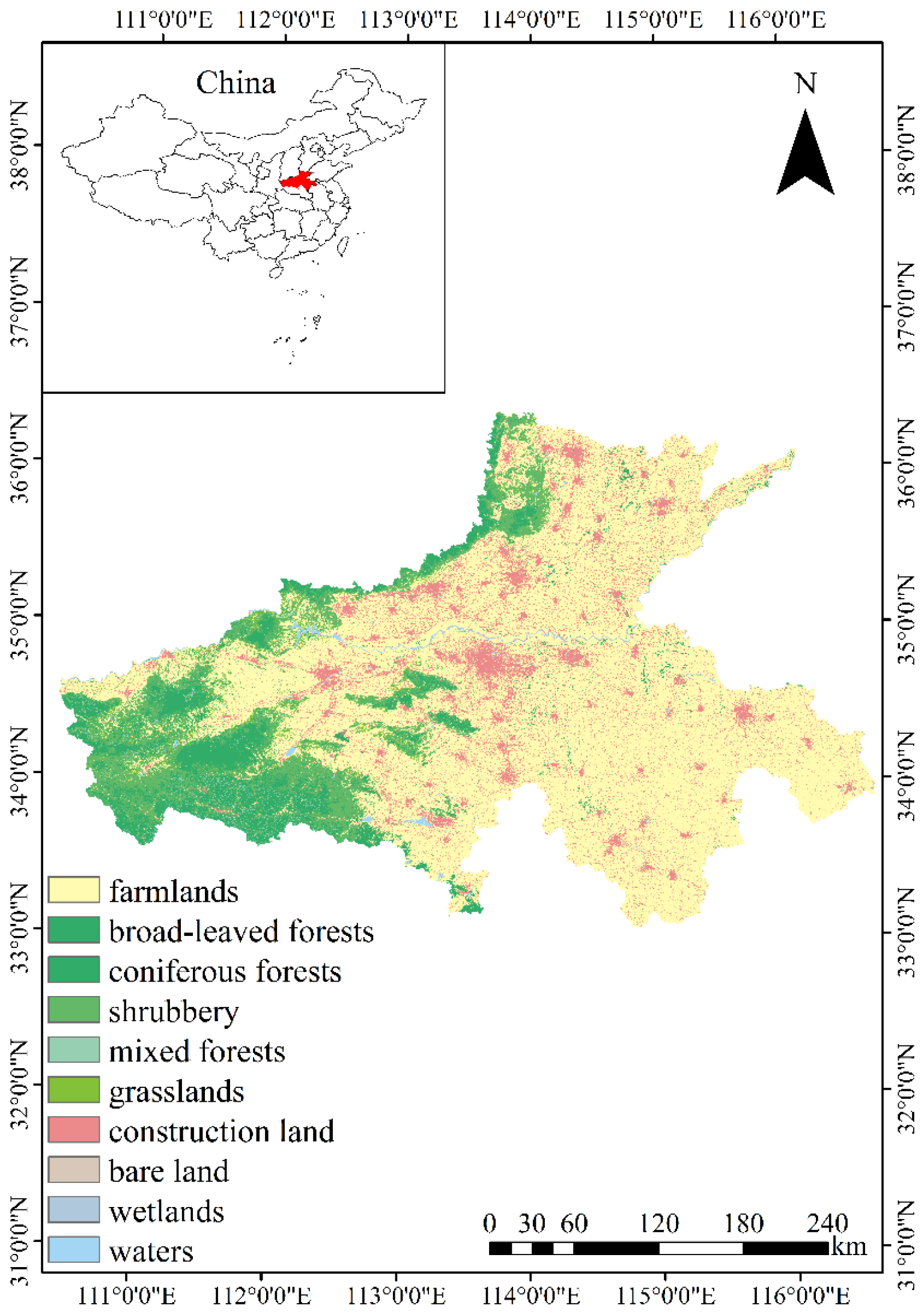






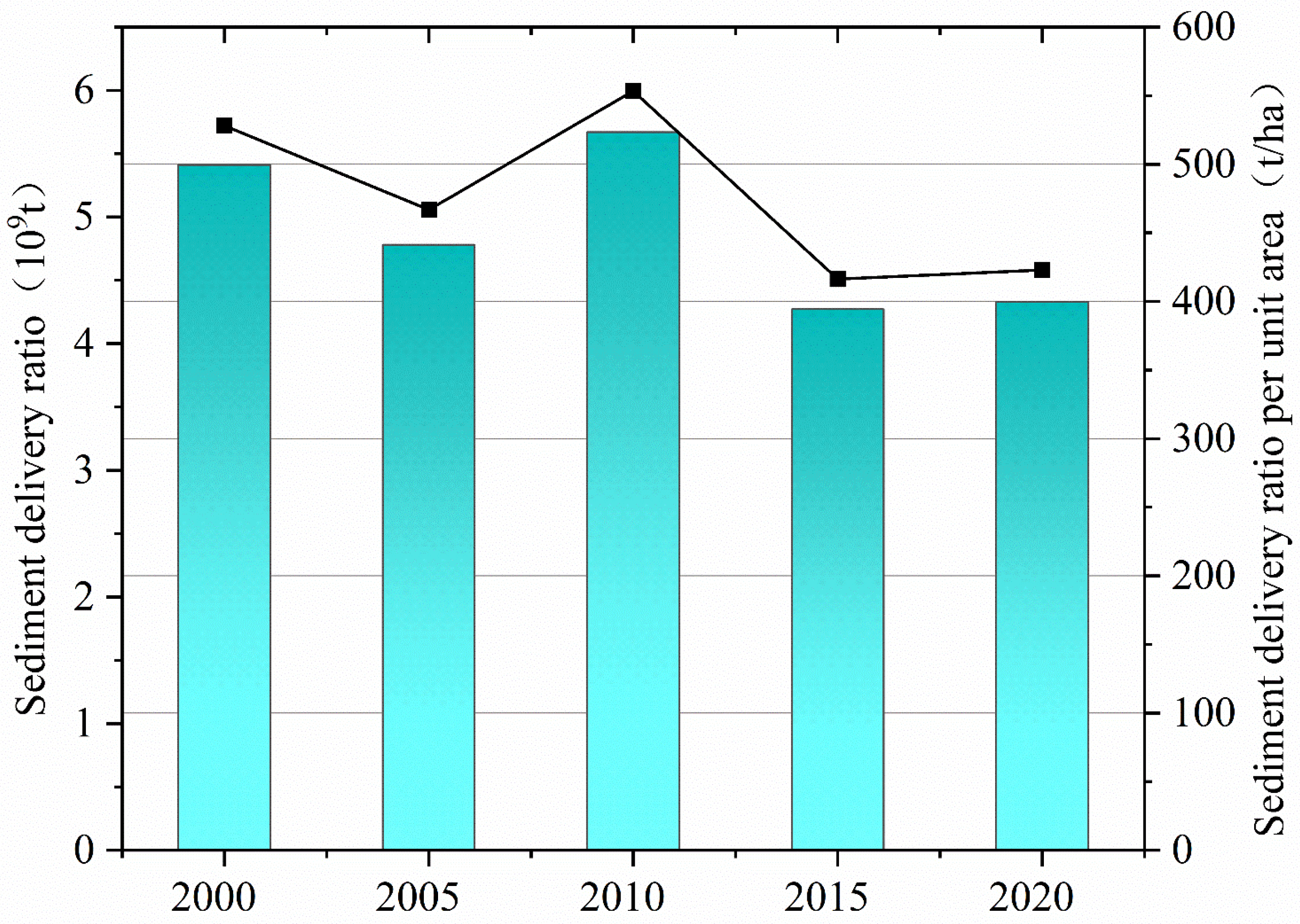
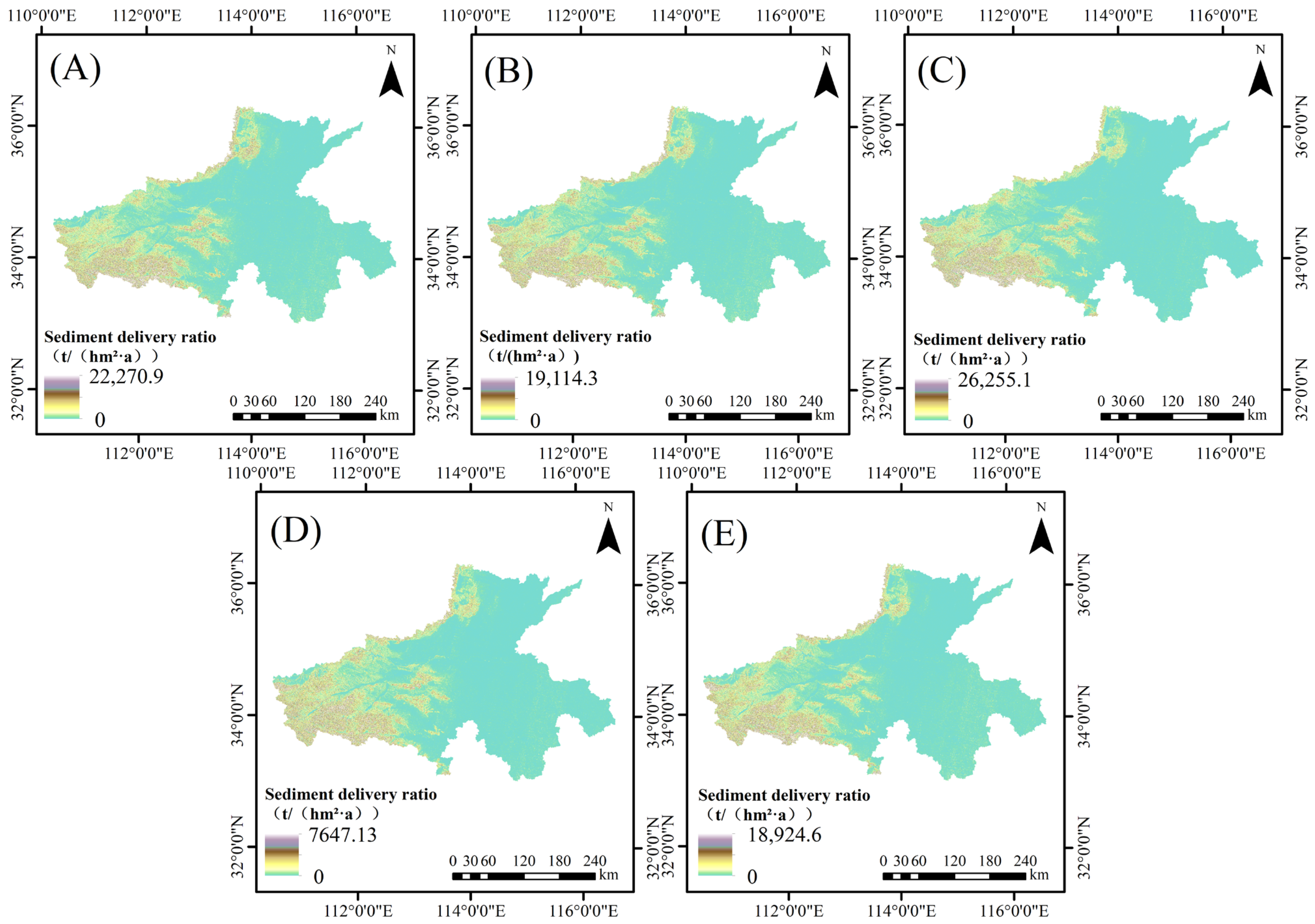
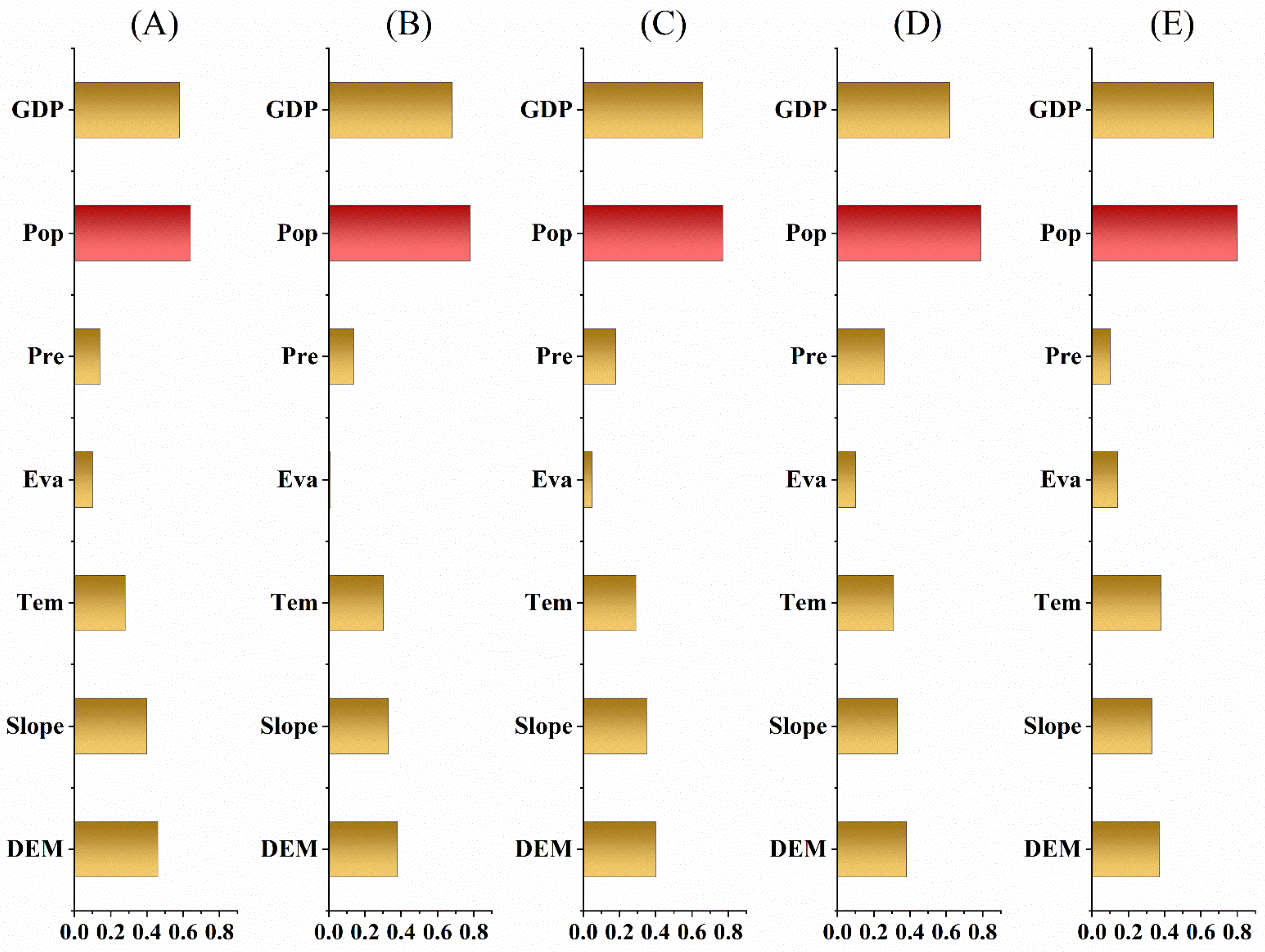

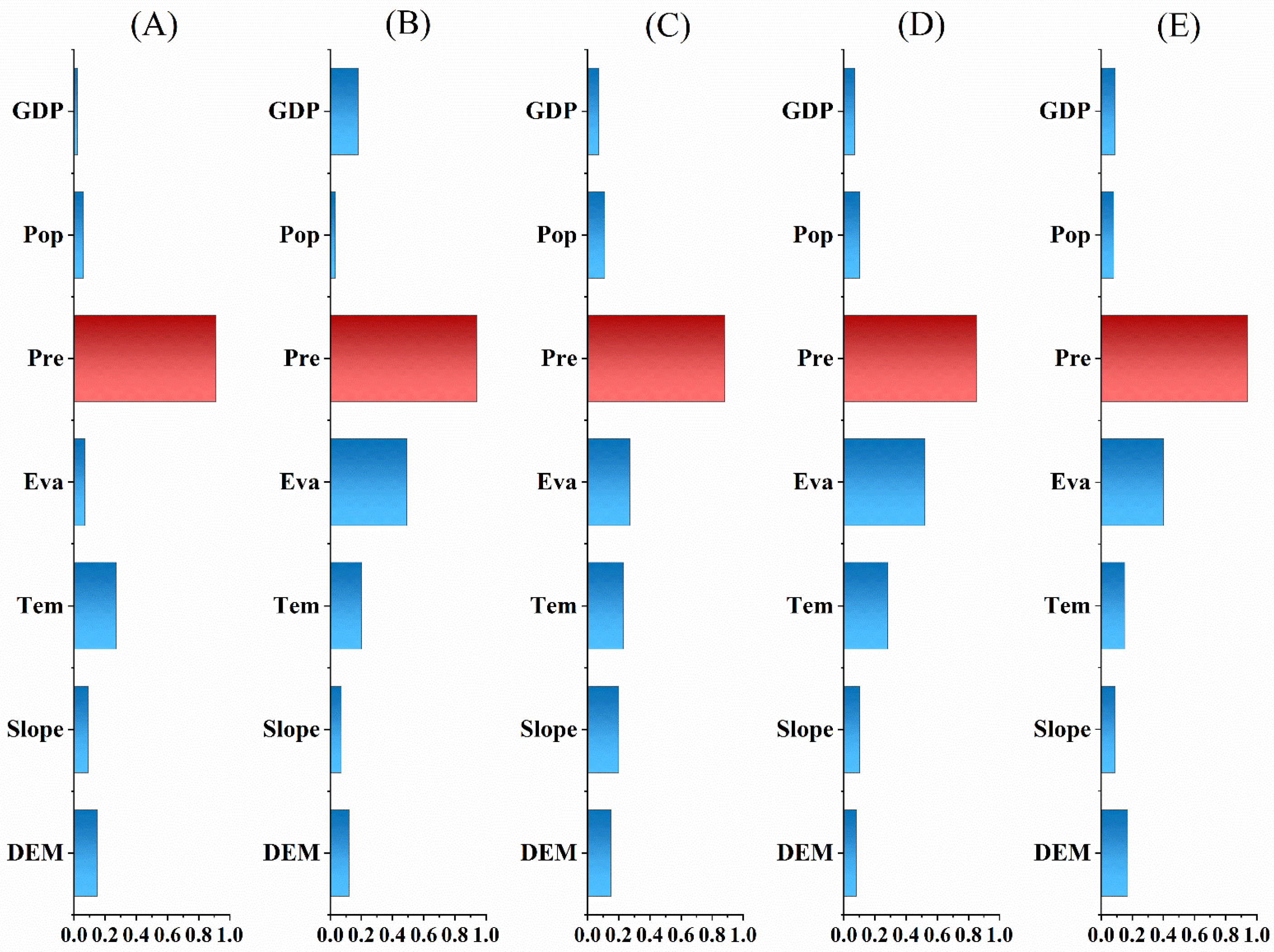
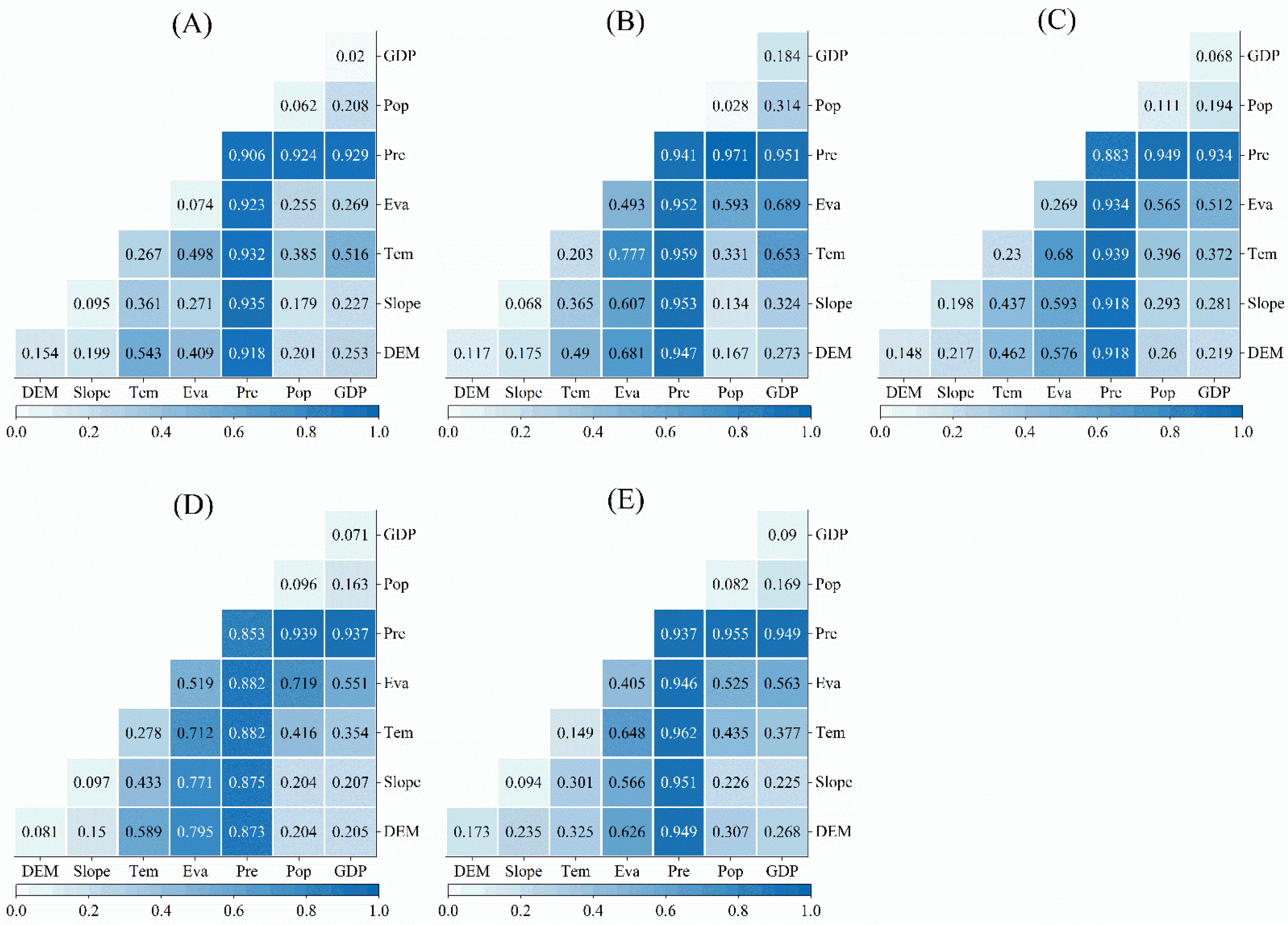
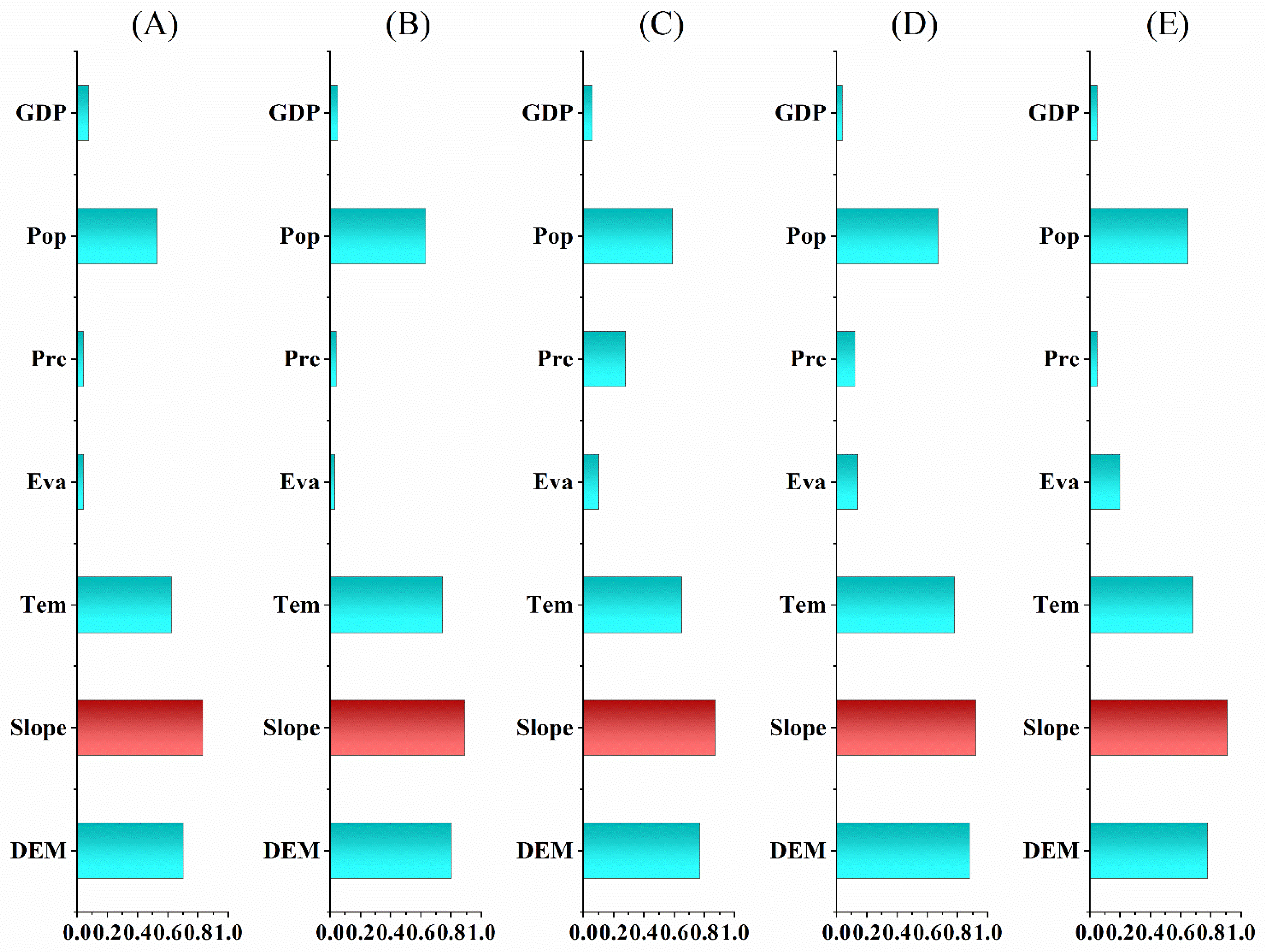

| Data Name | Data Sources | |
|---|---|---|
| Remote sensing data | Landsat image data | the Google Earth Engine (GEE) |
| GEDI L4A data | LP DACC (https://doi.org/10.3334/ORNLDAAC/1986, accessed on 23 August 2022) | |
| MOD17A3 data | NASA Earth Data Platform (https://earthdata.nasa.gov/, accessed on 23 August 2022) | |
| Land cover data | the Chinese Academy of Sciences Big Data Geoscience Project (https://data.casearth.cn, accessed on 30 July 2022) | |
| Meteorological data | Average annual temperature | the National Earth System Science Data Center (https://www.geodata.cn/, accessed on 5 September 2022) |
| Average annual precipitation | the Resource Environment Science and Data Center at the Institute of Geographic Sciences and Resources, the Chinese Academy of Sciences (https://www.resdc.cn, accessed on 5 September 2022) | |
| Average annual potential evapotranspiration | the Global Aridity and PET Database (https://cgiarcsi.community/data/global-aridity-and-pet-database/, accessed on 4 September 2022) | |
| The maximum root depth in the soil | Version 1.2 of the Harmonized World Soil Database | |
| DEM | the Geospatial Data Cloud (http://www.gscloud.cn/, accessed on 30 July 2022) |
| Code | LULC | Cabove | Cbelow | Csoil | Cdead |
|---|---|---|---|---|---|
| 1 | farmlands | 5.97 | 1.13 | 58.2 | 0 |
| 2 | broad-leaved forests | 13.95 | 5.58 | 89.9 | 5.55 |
| 3 | coniferous forests | 25.73 | 11.84 | 90.2 | 5.85 |
| 4 | shrubbery | 4.5 | 0.8 | 25 | 0 |
| 5 | coniferous and broad-leaved mixed | 6.5 | 1.4 | 67.3 | 0 |
| 6 | grasslands | 0.63 | 2.82 | 60.2 | 0.19 |
| 7 | construction land | 0 | 0 | 60 | 0 |
| 8 | bare land | 0 | 0 | 53.3 | 0 |
| 9 | wetlands | 3.7 | 6.55 | 0 | 1.23 |
| 10 | waters | 0 | 0 | 0 | 0 |
| Parameter | Source | Method | Formula |
|---|---|---|---|
| Slope | DEM | ArcGIS Extraction | — |
| DEM | DEM | — | — |
| NDVI | Landsat 8 band4, band5 | ENVI band operation | |
| EVI | Landsat 8 band2, band4, band5 | ENVI band operation |
| Training Data (R2) | Training Data (RMSE) | Testing Data (R2) | Testing Data (RMSE) | |
|---|---|---|---|---|
| Random forest regression | 0.66 | 24.82 | 0.56 | 28.68 |
| Geographically weighted regression | 0.72 | 22.47 | 0.67 | 25.12 |
| LULC | Soil Carbon Density (t/ha) |
|---|---|
| farmlands | 58.2 |
| broad-leaved forests | 89.9 |
| coniferous forests | 90.2 |
| shrubbery | 25 |
| coniferous and broad-leaved mixed | 67.3 |
| grasslands | 60.2 |
| construction land | 60 |
| bare land | 53 |
| wetlands | 26.2 |
| waters | 0 |
| Driving Factor | Unit (Unit of Measure) | Variable |
|---|---|---|
| Elevation | Meter | X1 |
| Slope | Degree | X2 |
| Mean annual temperature | Celsius degrees | X3 |
| Mean annual evapotranspiration | millimeter | X4 |
| Mean annual precipitation | millimeter | X5 |
| Population density | People/km2 | X6 |
| GDP | Ten thousand yuan | X7 |
| LULC | 2000 | 2005 | 2010 | 2015 | 2020 | |||||
|---|---|---|---|---|---|---|---|---|---|---|
| MEAN | SUM | MEAN | SUM | MEAN | SUM | MEAN | SUM | MEAN | SUM | |
| (t/ha) | (t) | (t/ha) | (t) | (t/ha) | (t) | (t/ha) | (t) | (t/ha) | (t) | |
| farmlands | 62.18 | 444,447,434 | 62.53 | 435,156,415 | 64.20 | 439,566,773 | 66.00 | 442,548,113 | 66.40 | 437,529,999 |
| broad-leaved forests | 124.66 | 131,357,701 | 124.44 | 133,199,681 | 128.24 | 134,955,449 | 130.73 | 137,125,932 | 133.06 | 139,182,232 |
| coniferous forests | 123.68 | 9,427,511 | 124.63 | 9,649,304 | 128.88 | 9,830,614 | 130.20 | 9,937,850 | 131.57 | 10,108,686 |
| shrubbery | 30.71 | 30,926,532 | 32.84 | 32,979,687 | 34.18 | 34,408,397 | 31.60 | 31,674,407 | 37.61 | 37,437,367 |
| coniferous and broad-leaved mixed | 104.79 | 5,431,361 | 103.22 | 5,665,145 | 109.03 | 5,651,559 | 110.45 | 5,716,760 | 113.30 | 5,847,339 |
| grasslands | 63.97 | 11,476,263 | 63.55 | 11,117,307 | 65.18 | 11,349,664 | 67.00 | 11,644,138 | 67.66 | 11,944,238 |
| construction land | 0.00 | 0 | 0.50 | 417,698 | 2.31 | 2,226,676 | 1.50 | 1,659,302 | 2.00 | 2,441,504 |
| bare land | 53.30. | 115,300 | 52.64 | 122,964 | 54.73 | 136,062 | 54.50 | 154,704 | 55.00 | 181,571 |
| wetlands | 2.62 | 33,714 | 4.51 | 66,048 | 3.64 | 60,137 | 4.38 | 89,127 | 4.34 | 110,167 |
| waters | 0.00 | 0 | 3.13 | 178,772 | 1.76 | 105,761 | 1.50 | 94,499 | 2.00 | 130,657 |
| LULC | 2000 | 2005 | 2010 | 2015 | 2020 | |||||
|---|---|---|---|---|---|---|---|---|---|---|
| MEAN | SUM | MEAN | SUM | MEAN | SUM | MEAN | SUM | MEAN | SUM | |
| (mm) | (105 m3) | (mm) | (105 m3) | (mm) | (105 m3) | (mm) | (105 m3) | (mm) | (105 m3) | |
| farmlands | 713.77 | 510,209.69 | 594.32 | 413,597.54 | 522.91 | 358,033.37 | 475.84 | 319,049.33 | 544.69 | 358,923.83 |
| broad-leaved forests | 722.74 | 76,159.51 | 678.63 | 72,640.21 | 743.11 | 78,200.93 | 574.01 | 60,209.19 | 643.17 | 67,275.35 |
| coniferous forests | 697.13 | 5313.98 | 670.82 | 5193.86 | 717.85 | 5475.56 | 561.39 | 4284.96 | 650.03 | 4994.40 |
| shrubbery | 685.71 | 69,044.43 | 624.03 | 62,670.26 | 670.03 | 67,454.21 | 544.42 | 54,572.63 | 569.18 | 56,649.54 |
| coniferous and broad-leaved mixed | 774.96 | 4016.66 | 738.79 | 4054.69 | 895.87 | 4643.53 | 614 | 3177.92 | 723.31 | 3733.11 |
| grasslands | 610.54 | 10,953.25 | 577.8 | 10,107.72 | 590.41 | 10,281.13 | 547.3 | 9511.06 | 549.24 | 9696.13 |
| construction land | 856.27 | 57,449.61 | 728.95 | 60,896.20 | 681.08 | 65,606.18 | 618.44 | 68,411.92 | 679.06 | 82,896.37 |
| bare land | 768.88 | 167.27 | 619.52 | 144.73 | 576.09 | 143.23 | 542.64 | 154.03 | 576.12 | 190.19 |
| wetlands | 595.11 | 764.66 | 525.69 | 769.36 | 443.73 | 733.02 | 419.07 | 852.25 | 463.19 | 1175.82 |
| waters | 673.83 | 3258.69 | 571.6 | 3262.41 | 515.24 | 3091.24 | 491.71 | 3097.75 | 526 | 3436.28 |
| total | — | 737,337.76 | — | 633,336.97 | — | 593,662.40 | — | 523,321.041 | — | 588,971.04 |
| LULC | 2000 | 2005 | 2010 | 2015 | 2020 | |||||
|---|---|---|---|---|---|---|---|---|---|---|
| MEAN | SUM | MEAN | SUM | MEAN | SUM | MEAN | SUM | MEAN | SUM | |
| (t/ha) | (t) | (t/ha) | (t) | (t/ha) | (t) | (t/ha) | (t) | (t/ha) | (t) | |
| farmlands | 124.94 | 892,894,647 | 105.2 | 731,992,472 | 103.65 | 709,523,148 | 96.65 | 647,782,320 | 94.14 | 618,244,237 |
| broad-leaved forests | 2168.86 | 2,284,766,697 | 1941.71 | 2,077,785,374 | 2430.82 | 2,557,282,693 | 1713.45 | 1,795,713,278 | 1855.4 | 1,926,287,063 |
| coniferous forests | 2715.86 | 206,904,023 | 2519.13 | 194,929,844 | 2968.51 | 226,300,551 | 2154.01 | 164,150,571 | 2416.8 | 183,063,619 |
| shrubbery | 1645.64 | 1,656,878,548 | 1421.69 | 1,427,664,880 | 1745.19 | 1,756,810,566 | 1314.88 | 1,317,780,576 | 1274.36 | 1,264,849,202 |
| coniferous and broad-leaved mixed | 2886.14 | 149,523,934 | 2600.01 | 142,635,418 | 3601.08 | 186,570,303 | 2174.02 | 112,423,976 | 2520.69 | 128,984,358 |
| grasslands | 858.5 | 153,989,292 | 821.87 | 143,749,763 | 940.12 | 163,681,336 | 886.62 | 153,982,268 | 724.27 | 127,479,804 |
| construction land | 86.93 | 58,321,795 | 67.87 | 56,696,949 | 65.44 | 63,033,507 | 59.17 | 65,448,329 | 62.22 | 75,892,169 |
| bare land | 315.69 | 686,692 | 230.92 | 539,324 | 223.65 | 555,891 | 191.38 | 543,039 | 176.91 | 582,019 |
| wetlands | 141.02 | 1,803,907 | 115.99 | 1,690,840 | 104.17 | 1,714,350 | 91.11 | 1,843,971 | 84.97 | 2,055,458 |
| waters | 146.41 | 7,073,007 | 119.22 | 6,798,493 | 116.85 | 7,004,450 | 112.39 | 7,064,835 | 105.88 | 6,741,030 |
| Type of Forest | 2000 | 2005 | 2010 | 2015 | 2020 |
|---|---|---|---|---|---|
| evergreen forests | 58.93 | 58.36 | 60.37 | 62.11 | 63.69 |
| shrubbery | 11.43 | 12.21 | 12.36 | 13.20 | 13.23 |
Disclaimer/Publisher’s Note: The statements, opinions and data contained in all publications are solely those of the individual author(s) and contributor(s) and not of MDPI and/or the editor(s). MDPI and/or the editor(s) disclaim responsibility for any injury to people or property resulting from any ideas, methods, instructions or products referred to in the content. |
© 2024 by the authors. Licensee MDPI, Basel, Switzerland. This article is an open access article distributed under the terms and conditions of the Creative Commons Attribution (CC BY) license (https://creativecommons.org/licenses/by/4.0/).
Share and Cite
Fan, L.; Wang, X.; Chen, Z.; Chen, R.; Liu, X.; He, Y.; Wang, S. Analysis of Spatial and Temporal Evolution of Ecosystem Services and Driving Factors in the Yellow River Basin of Henan Province, China. Forests 2024, 15, 1547. https://doi.org/10.3390/f15091547
Fan L, Wang X, Chen Z, Chen R, Liu X, He Y, Wang S. Analysis of Spatial and Temporal Evolution of Ecosystem Services and Driving Factors in the Yellow River Basin of Henan Province, China. Forests. 2024; 15(9):1547. https://doi.org/10.3390/f15091547
Chicago/Turabian StyleFan, Liting, Xinchuang Wang, Zhichao Chen, Runbo Chen, Xuejie Liu, Yateng He, and Shunzhong Wang. 2024. "Analysis of Spatial and Temporal Evolution of Ecosystem Services and Driving Factors in the Yellow River Basin of Henan Province, China" Forests 15, no. 9: 1547. https://doi.org/10.3390/f15091547





